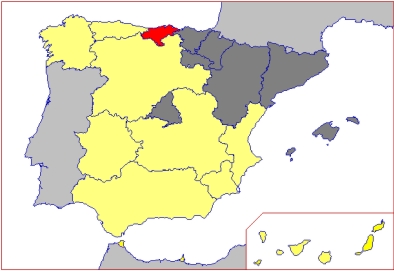|
|
|
|
|
|
|
|
|
|
 INTRODUCTION INTRODUCTION
-
 The
European Social fund can be used in areas included under the
three objectives to which the action and budgetary resources
of the Structural Funds for the period 2000-2006 are aimed,
by financing measures geared towards combating unemployment
and fomenting the development of human resources. The new Regulations
for the European Social Fund establish a series of priority
areas of action, in which active labour market policies, vocational
training and the improvement of the labour situation of women
are the most important. These strategies correspond to and are
coherent with those set forth in the so-called European
Employment Strategy (EES) and the National
Plan for Employment Action (PNAE) in Spain. The
European Social fund can be used in areas included under the
three objectives to which the action and budgetary resources
of the Structural Funds for the period 2000-2006 are aimed,
by financing measures geared towards combating unemployment
and fomenting the development of human resources. The new Regulations
for the European Social Fund establish a series of priority
areas of action, in which active labour market policies, vocational
training and the improvement of the labour situation of women
are the most important. These strategies correspond to and are
coherent with those set forth in the so-called European
Employment Strategy (EES) and the National
Plan for Employment Action (PNAE) in Spain.
-
 For
the new programme period 2000-2006 community actions
have been simplified and, as provided in the priority objectives
to which this structural policy is geared, have been reduced
to 3, compared to the 7 of the previous period: For
the new programme period 2000-2006 community actions
have been simplified and, as provided in the priority objectives
to which this structural policy is geared, have been reduced
to 3, compared to the 7 of the previous period:
-
 Objective
1 is aimed at fomenting the development and structural
adjustment of regions whose development is lagging behind,
those whose per capita GDP is less than 75% of the community
average, to which the ERDF,
ESF, the
Guidance Section of the EAGGF-G and the FIFG will contribute. Objective
1 is aimed at fomenting the development and structural
adjustment of regions whose development is lagging behind,
those whose per capita GDP is less than 75% of the community
average, to which the ERDF,
ESF, the
Guidance Section of the EAGGF-G and the FIFG will contribute.
-
 The
aim of Objective 2 is to support economic and social
conversion in areas facing structural difficulties, whether
they be industrial areas, areas which depend on service
industries, declining rural areas, urban areas in difficulty,
or depressed areas dependent on fisheries. The populations
of these areas, which are located outside the Objective
2 regions, can not represent more than 18% of the total
population of the EU.
The ERDF, ESF
and the Guarantee Section of the EAGGF-G contribute to
this Objective. The
aim of Objective 2 is to support economic and social
conversion in areas facing structural difficulties, whether
they be industrial areas, areas which depend on service
industries, declining rural areas, urban areas in difficulty,
or depressed areas dependent on fisheries. The populations
of these areas, which are located outside the Objective
2 regions, can not represent more than 18% of the total
population of the EU.
The ERDF, ESF
and the Guarantee Section of the EAGGF-G contribute to
this Objective.
-
 Objective
3 is geared towards the adaptation and modernisation
of educational, training and employment policies and systems,
with the sole support of the ESF. Financially this objective
acts outside the regions included in Objective 1. Objective
3 is geared towards the adaptation and modernisation
of educational, training and employment policies and systems,
with the sole support of the ESF. Financially this objective
acts outside the regions included in Objective 1.
-
 In
Spain the following areas belong to Objective 1 : Andalusia,
Asturias, Canary Islands, Castilla la Mancha, Castilla y León,
Autonomous Regions of Valencia, Extremadura, Galicia, Murcia,
Ceuta and Melilla. Cantabria receives transitory aid proceeding
from Objective 1.. In
Spain the following areas belong to Objective 1 : Andalusia,
Asturias, Canary Islands, Castilla la Mancha, Castilla y León,
Autonomous Regions of Valencia, Extremadura, Galicia, Murcia,
Ceuta and Melilla. Cantabria receives transitory aid proceeding
from Objective 1..
-
 Outside
of Objective 1, the following regions receive assistance proceeding
from Objectives 2 and 3: Aragón, Balearic Islands, Cataluña,
Madrid, Navarra, Basque Country and La Rioja. Outside
of Objective 1, the following regions receive assistance proceeding
from Objectives 2 and 3: Aragón, Balearic Islands, Cataluña,
Madrid, Navarra, Basque Country and La Rioja.
| |
Regions of CSF
Objective 1 |
| |
Regions of CSF
Objective 3 and SPD Objective 2 |
| |
Regions of CSF
Objective 1 (Transitional Assistance) |
|
 |
-
 Prior
to the planning of the programme to be implemented jointly by
the Community and each member state, the Plans for each one
of the three Objectives are presented for the period 2000-2006: Prior
to the planning of the programme to be implemented jointly by
the Community and each member state, the Plans for each one
of the three Objectives are presented for the period 2000-2006:
-
 The
Plan for Objective 1 is called Regional Development Plan
and encompasses all of the structural actions in the affected
regions. The
Plan for Objective 1 is called Regional Development Plan
and encompasses all of the structural actions in the affected
regions.
-
 For
Objective 2, a set of programme proposals are presented,
and will give rise to the SPD. For
Objective 2, a set of programme proposals are presented,
and will give rise to the SPD.
-
 The
Objective 3 Plan has two main features: : The
Objective 3 Plan has two main features: :
-
It encompasses ESF actions in regions
outside Objective 1
-
It establishes, for all of the national
territory, the Political Reference Framework for the
Development of Human Resources, which is the national
strategic guideline applicable to all measures related
to employment and the labour market.
-
 Therefore,
the Plans are used to set the foundations to reconcile the general
and final objectives of actions with the specific situation
in each country. Therefore,
the Plans are used to set the foundations to reconcile the general
and final objectives of actions with the specific situation
in each country.
-
 The
presentation of the Plan for Objective 3 fulfils two
functions: to guarantee the coherence of all actions undertaken
in favour of human resources throughout the state and to provide
financing from the ESF for assistance actions in regions which
are not included in Objective 1. The
presentation of the Plan for Objective 3 fulfils two
functions: to guarantee the coherence of all actions undertaken
in favour of human resources throughout the state and to provide
financing from the ESF for assistance actions in regions which
are not included in Objective 1.
The contents of the Plan for Objective 3
provide:
-
 An
analysis of employment policies An
analysis of employment policies
-
 The
results of the main actions in Spain in recent years related
to the development of human resources. The
results of the main actions in Spain in recent years related
to the development of human resources.
-
 The
main guidelines of actions planned for the period 2000-2006. The
main guidelines of actions planned for the period 2000-2006.
-
 An
analysis of the coherence of planned actions with the provisions
of the National Employment Action Plan. An
analysis of the coherence of planned actions with the provisions
of the National Employment Action Plan.
|
|
